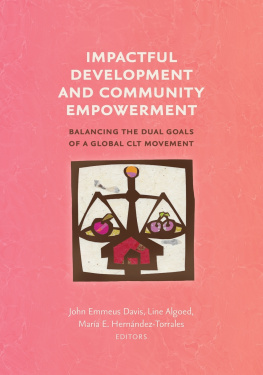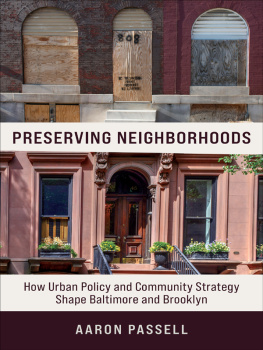John Emmeus Davis - Community Land Trust Applications in Urban Neighborhoods
Here you can read online John Emmeus Davis - Community Land Trust Applications in Urban Neighborhoods full text of the book (entire story) in english for free. Download pdf and epub, get meaning, cover and reviews about this ebook. year: 2020, publisher: CLT Innovation, genre: Politics. Description of the work, (preface) as well as reviews are available. Best literature library LitArk.com created for fans of good reading and offers a wide selection of genres:
Romance novel
Science fiction
Adventure
Detective
Science
History
Home and family
Prose
Art
Politics
Computer
Non-fiction
Religion
Business
Children
Humor
Choose a favorite category and find really read worthwhile books. Enjoy immersion in the world of imagination, feel the emotions of the characters or learn something new for yourself, make an fascinating discovery.
- Book:Community Land Trust Applications in Urban Neighborhoods
- Author:
- Publisher:CLT Innovation
- Genre:
- Year:2020
- Rating:5 / 5
- Favourites:Add to favourites
- Your mark:
- 100
- 1
- 2
- 3
- 4
- 5
Community Land Trust Applications in Urban Neighborhoods: summary, description and annotation
We offer to read an annotation, description, summary or preface (depends on what the author of the book "Community Land Trust Applications in Urban Neighborhoods" wrote himself). If you haven't found the necessary information about the book — write in the comments, we will try to find it.
Community Land Trust Applications in Urban Neighborhoods — read online for free the complete book (whole text) full work
Below is the text of the book, divided by pages. System saving the place of the last page read, allows you to conveniently read the book "Community Land Trust Applications in Urban Neighborhoods" online for free, without having to search again every time where you left off. Put a bookmark, and you can go to the page where you finished reading at any time.
Font size:
Interval:
Bookmark:


A Common Ground Monograph


Center for Community Land Trust Innovation
3146 Buena Vista Street
Madison, Wisconsin, USA 53704
Copyright 2020 Center for CLT Innovation.
All rights reserved. No part of this publication may be reproduced, distributed, or
transmitted in any form or by any means or stored in a database or retrieval system
without the prior written permission of the Center for Community Land Trust
Innovation, except in the case of brief quotations embedded in critical articles and
reviews. For requests for permission to reprint portions of this book, please contact
Publishers Cataloging-in-Publication Data
Names: Davis, John Emmeus, editor. | Algoed, Line, editor. | Hernndez-Torrales, Mara E., editor.
Title: Community land trust applications in urban neighborhoods. / John Emmeus Davis; Line Algoed; Mara E. Hernndez-Torrales, editors.
Series: Common Ground Monographs
Description: Includes bibliographical references. | Madison, WI: Terra Nostra Press, 2020.
Identifiers: Library of Congress Control Number: 2020920161 |
ISBN: 978-1-7344030-7-7 (paperback) | ISBN: 978-1-7344030-8-4 (ebook)
Subjects: LCSH Land trusts. | Land tenure. | Land use. | Land use, Urban. | Nature conservation. | Landscape protection. | Sustainable development. | Economic developmentEnvironmental aspects. | City planningEnvironmental aspects. | Community development. | Urban ecology (Sociology) | BISAC POLITICAL SCIENCE / Public Policy / City Planning & Urban Development | LAW / Housing & Urban Development | BUSINESS & ECONOMICS / Development / Sustainable Development | SOCIAL SCIENCE / Sociology / Urban
Classification: LCC KF736.L3 W49 2020 | DDC 333.2dc23
CONTENTS
FIGURES
Introduction
On Common Ground

John Emmeus Davis, Line Algoed,
and Mara E. Hernndez-Torrales
When community land trusts (CLTs) began appearing in the United States during the 1970s, all of them were located in rural areas. Most were constructed along lines laid down in the first book to describe this new model for land tenure in America published in 1972,
By the 1980s and 1990s, this innovative form of tenure was spreading into cities, suburbs, and towns. The concerns of this new generation of urban CLTs were somewhat different that those of their rural predecessors. Homeownership remained a priority for most of them, but other activities and applications got added to the mix: revitalizing the built environment in distressed neighborhoods; preventing the displacement of low-income residents in gentrifying neighborhoods; and developing multiple types and tenures of permanently affordable housing, going beyond the detached, single-family, owner-occupied houses that were the programmatic focus of CLTs in more rural areas. The housing constructed (or rehabilitated) by CLTs in cities included townhouses, condominiums, limited-equity cooperatives, multi-family rentals, rooming houses, and facilities for the homeless. Some urban CLTs started going beyond housing as well, developing non-residential buildings for stores, restaurants, clinics, community centers, or facilities for other nonprofit organizations providing various goods and services for neighborhood residents. A few CLTs made vacant lots and larger parcels of land available for activities that evoked the models rural pedigree, including greenhouses, community gardens, and small-scale commercial agriculture.
Today, a majority of community land trusts throughout the world are urban. Although CLTs are still being organized and operated in rural villages and towns, especially in England, the greatest growth in the global CLT movement has been occurring in the residential neighborhoods and inner-ring suburbs of cities small, medium, and large. Most of this growth has happened in the Global North in cities like Boston, Brussels, Denver, London, Montreal, Oakland, and Toronto. More recently, however, urban CLTs have been appearing in the Global South as well, inspired in part by the Fideicomiso de la Tierra del Cao Martn Pea in San Juan, Puerto Rico. This urban CLT, after years of community-based organizing and planning, gained title to multiple parcels of publicly owned land underneath seven densely populated informal settlements along a tidal channel in the citys midst. As a result, the homes of 1500 families who had long lived precariously on lands they had not had a legal right to occupy were protected.
The work of the Cao Martn Pea CLT has caught the attention of community activists in other countries facing similar problems of land and housing insecurity. Brazil is a prime example. In Rio de Janeiro alone, 1.4 million people reside in a thousand informal settlements known as favelas. Several years ago, a network of leaders from several of Rios favelas, supported by an NGO named Catalytic Communities, learned of the Cao CLT. They began exploring whether a CLT might be applied to regularizing land tenure beneath a favelas built environment. They invited representatives from the Cao CLT to visit Rio and offer advice on how they might organize CLTs of their own. This was the start of a formative, participatory planning process that is still unfolding.
Urbanists at the United Nations have also taken note of CLTs. At the 2016 UN Conference on Housing and Sustainable Urban Development in Quito, Ecuador, community land trusts were among the policies, tools, mechanisms, and financing models named in the New Urban Agenda for promoting access to housing and for making cities more inclusive. CLTs were touted as one of several cooperative solutions for addressing, in the Agendas words, the evolving needs of persons and communities, in order to improve the supply of housing, especially for low-income groups, prevent segregation, and [prevent] arbitrary forced evictions and displacements...with special attention to programmes for upgrading slums and informal settlements.
Most urban CLTs do, in fact, have a programmatic focus on promoting and preserving access to housing, especially for low-income groups. And many give special attention to addressing the needs of people at risk of being displaced, either because they are residing on lands for which they do not hold formal title or because they are being priced out of areas where land values and housing costs are rapidly rising.
This puts the emerging CLT movement at the intersection of two world-wide movements for social change. The first is occurring in countries where people who are land-insecure are struggling to gain recognition, registration, and legal protection for acreage that is occupied under some form of informal landholding system. As in San Juan and Rio, not all of this land is rural. Many informal settlements are to be found in major and minor cities in Latin America, Asia, and Africa.
CLTs are also aligned with a rising tide of advocacy and action around housing rights that is evident in cities around the world. The issues being championed by this amorphous movement for a right to the city include rent control, community-led development, and the production and preservation of housing that remains permanently affordable. Popular support for CLTs and similar forms of community-controlled land and housing is surfacing amidst ongoing battles to prevent the displacement of classes and races at constant risk of being pushed aside by government investment in major infrastructure or private investment in upscale development. Such risks become especially acute and protective interventions like a CLT become especially attractive during periods of economic disruption when disaster capitalists lurk in the wings, waiting for any chance to buy up homes lost to foreclosure or to buy up lands cleared by wildfires, hurricanes, or floods.
Font size:
Interval:
Bookmark:
Similar books «Community Land Trust Applications in Urban Neighborhoods»
Look at similar books to Community Land Trust Applications in Urban Neighborhoods. We have selected literature similar in name and meaning in the hope of providing readers with more options to find new, interesting, not yet read works.
Discussion, reviews of the book Community Land Trust Applications in Urban Neighborhoods and just readers' own opinions. Leave your comments, write what you think about the work, its meaning or the main characters. Specify what exactly you liked and what you didn't like, and why you think so.








